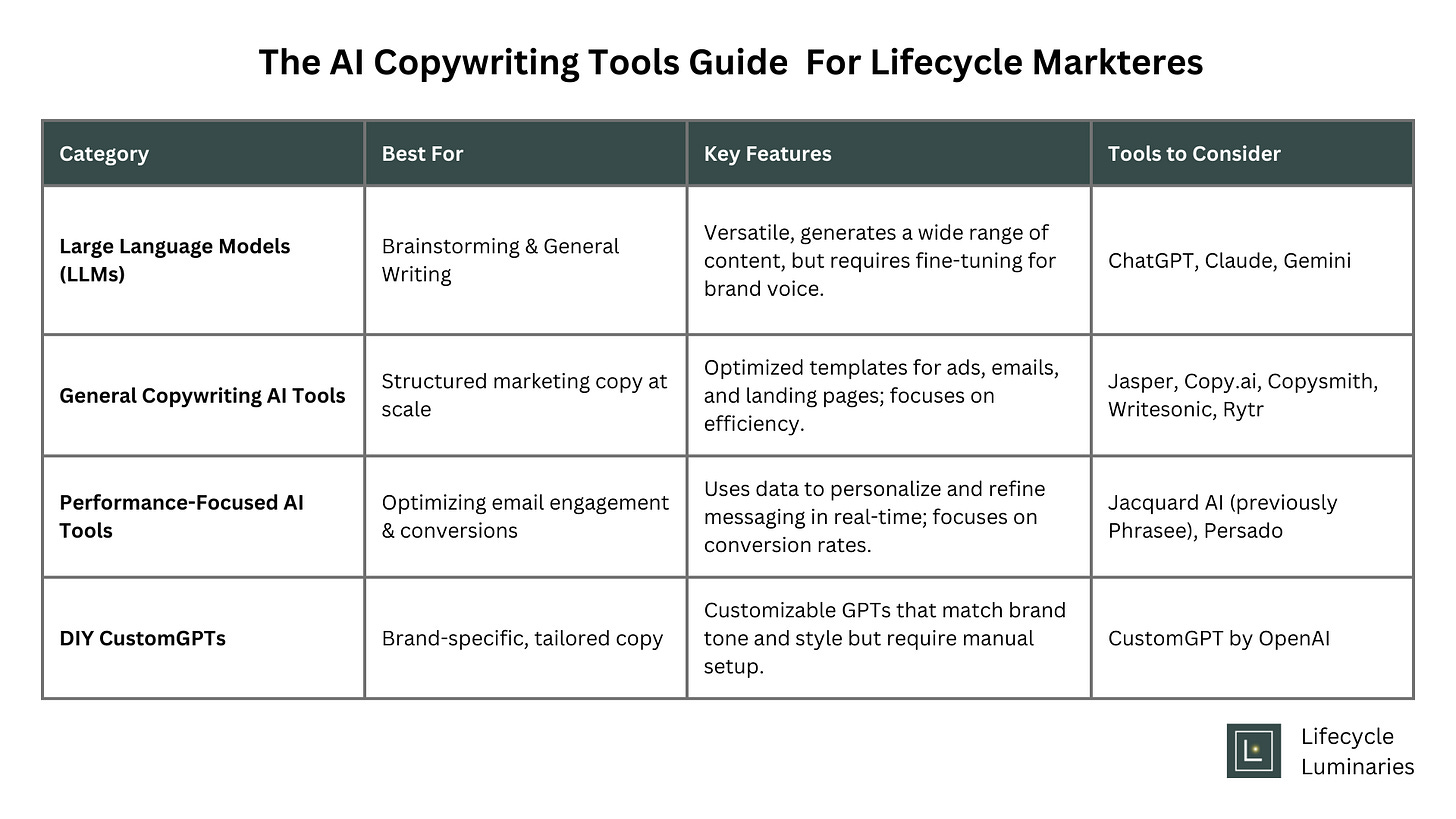AI Copywriting Guide & Top Tools For Lifecycle Marketers
A guide to how AI can aid your email copywriting process—from content generation to personalization and optimization.
Join our Slack community and Substack to join the conversation and stay up-to-date on the latest.
Marketers today face a dilemma: create high-quality copy quickly or maintain personalization and brand voice. AI promises both—but does it deliver? With so many AI-powered writing tools available, how do you choose the right one?
This guide cuts through the noise by breaking AI copywriting tools into three categories, helping you choose the right tool based on whether you need content generation, personalized messaging, or performance optimization.
Large Language Models (LLMs)
LLMs are the most flexible AI writing tools, capable of generating everything from blog posts to ad copy and product descriptions. Trained on vast datasets, they predict and produce human-like, engaging text. Examples include ChatGPT, Claude, Gemini, and others—these tools are general-purpose, meaning they can sometimes produce content that feels generic.
Pros & Cons
✅ Can create a wide variety of content across multiple formats.
✅ Great for brainstorming, drafting, and rewriting.
❌ Doesn’t optimize for conversions—it generates, but doesn’t test or refine.
❌ Needs fine-tuning to match a brand’s unique style and tone.
General Copywriting AI Tools
If you're looking for high-quality, structured marketing copy at scale, these AI tools are designed specifically for that purpose. Unlike LLMs, they focus on marketing use cases like ads, landing pages, email sequences, and product descriptions.
In addition to copywriting, these tools often offer a range of other services, including prospecting, translation, and account-based marketing (ABM), making them comprehensive solutions for your marketing needs.
Tools to Consider
Jasper.ai: Offers an extensive email template library with advanced customization (brand voice, Boss Mode) for consistent, on-brand campaigns.
Copy.ai: A user-friendly, budget-conscious option that quickly generates engaging email subject lines and body copy.
Copysmith.ai: Provides specialized email templates for cold outreach, follow-ups, and marketing emails, delivering strong initial drafts.
Writesonic: Focuses on conversion-driven emails with data-backed suggestions and dynamic variations to boost engagement.
Rytr: A cost-effective, intuitive tool ideal for startups and small businesses, producing quick, customizable email drafts.
Pros & Cons
✅ Faster than LLMs because it uses templates designed for marketing.
✅ Creates structured, formatted content instantly.
❌ Mainly for writing, but don’t optimize messaging at scale
Performance-focused AI Tools
Creating content is one thing—getting people to take action is another. These AI tools analyze performance, personalize messaging, and refine content in real-time to boost engagement and drive sales.
By establishing a rapid feedback loop, these platforms identify the best-performing copy for brands, helping maximize conversions and improve overall effectiveness.
Tools to Consider
Jacquard AI (previously Phrasee): Uses AI to generate and optimize emotionally resonant email copy. It analyzes past campaign data to determine which language drives the best responses and refines your messaging over time.
Persado: Specializes in creating optimized subject lines and email copy. By learning from engagement metrics, Phrasee adjusts its language to maximize open rates and click-throughs.
Pros & Cons
✅ Personalized messaging based on customer behavior.
✅ Continuously refines copy to improve performance.
❌ Requires integration with other marketing tools to be effective.
DIY Customization: CustomGPTs in ChatGPT
For marketers who just want to see how good brand-tailored copywriting can be, CustomGPTs from OpenAI are a cost-effective solution.
By adding instructions on brand voice, preferred phrasing, and even setting content restrictions, you can ensure that the AI-generated text aligns more closely with your brand’s identity. This customization allows you to get more relevant, on-brand content, making LLMs a powerful tool for your marketing efforts without sacrificing personality or authenticity.
Pros & Cons
✅ Allows for customization to match your brand’s tone and style.
✅ Cost-effective ($20/mo) and easily accessible
❌ Requires initial time investment to set up and train the model.
❌ May need continuous fine-tuning to stay aligned with evolving brand guidelines.
Which tool(s) should you use?
Here's a comparison table that breaks down the AI copywriting tools based on their key features and use cases that you can consider depending on your use case:
AI Copy Assist Tools in ESPs: Still Evolving
While many leading ESPs like Iterable and Salesforce Marketing Cloud have integrated AI tools to help with copywriting, these features are still evolving. Unlike standalone AI copywriting platforms, which are more mature and offer advanced optimization and personalization, these ESP-based tools are still catching up in terms of capabilities. They offer useful suggestions for improving copy, but they may not yet match the depth and sophistication of specialized tools. For lifecycle marketers, these tools are a good starting point but may need to be complemented with other AI solutions as the technology matures.
Conclusion
AI copywriting tools are revolutionizing email marketing, making it easier to create, personalize, and optimize messaging at scale. Whether you need fast content generation, structured marketing copy, or performance-driven optimization, there’s an AI tool to fit your needs.
As AI continues to evolve, new possibilities emerge—so which area interests you most? Would you like a deep dive into AI-driven personalization, real-time copy optimization, or best practices for training CustomGPTs? Let me know in the comments!
Join our Slack community and Substack to stay up-to-date on the latest.


